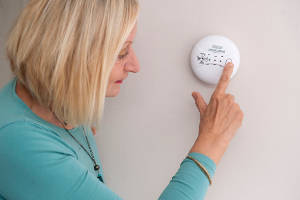
20 Aug 2018 Protecting yourself from carbon monoxide
A large number of us have a fireplace or wood-burning stove at home nowadays. More and more of us are choosing it for heating either as a primary source of heat in a room, or as a secondary one in our lounges and living rooms. But with them come certain safety precautions that we need to consider. This month we are focusing on carbon monoxide. With the summer period an ideal time to service our fireplaces and stoves (not to mention our boilers and any other fuel-burning appliances we have at home) it is also the right time to make sure we are safe from carbon monoxide.
What is carbon monoxide?
Carbon monoxide is formed when a fuel burns without enough oxygen so it does not burn properly. Many of us associate it with gas, but the reality is that it can happen with the combustion of any fuel in a poorly ventilated environment. It is formed when insufficient oxygen means that carbon monoxide is produced during combustion instead of carbon dioxide. When inhaled it binds with the oxygen in our body and prevents it from getting around our body and reaching our blood cells in order to nourish us.
Carbon monoxide leaks can occur when chimneys and flues are blocked, or if there is a gas leak in a poorly ventilated area – the home or garage for example.
What are the symptoms?
Carbon monoxide poisoning can happen very quickly. If the leak is small, it could lead to low-level symptoms that can easily be confused with food poisoning or the flu. The symptoms include the following:
- Headaches – it may feel like a tension headache
- Dizziness and shortness of breath
- Confusion and tiredness
- Nausea or vomiting
- Stomach pain
What to do if you suspect a carbon monoxide leak
If this happens, you should do the following:
- Turn off all appliances that do not use electricity.
- Open windows and doors to increase ventilation.
- Get out of the house immediately.
- Call the gas emergency number on 0800 111 999.
- Remain outside until you are told that it’s safe to go back in.
- Get yourself checked by a doctor. If you have been affected you may not realise and the clearer air outdoors will not be sufficient treatment.
Things to look out for
As well as being aware of how you feel, a low-level leak could be causing you problems which are not severe enough for you to connect to carbon monoxide poisoning. In particular, be aware of:
- Any others, including pets, who may fall ill even if you don’t. They may be more susceptible to smaller changes in air quality.
- Symptoms improving when you leave the house and coming back on your return. Similarly, if they only occur in the winter when you are more likely to have closed windows and working appliances, this could indicate a low-level leak.
- Black or sooty stains on gas fire covers or yellow stains on and around stoves or fires.
- A build-up of smoke, which could indicate a faulty flue.
Installing a carbon monoxide alarm is an excellent way of getting early warning of any problems before they become worse.
For advice on how to stay safe from carbon monoxide poisoning or for a check and service of any fireplaces or stoves, call our Fiveways Fires & Stoves team for help. We are on 020 8127 4747 or you can drop us a line at and we’ll sort it out for you.


